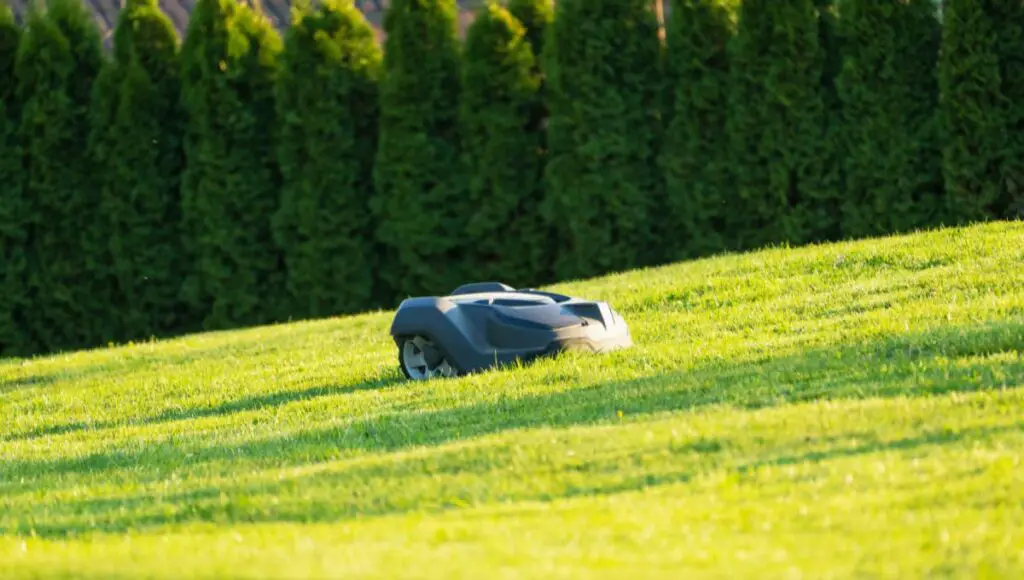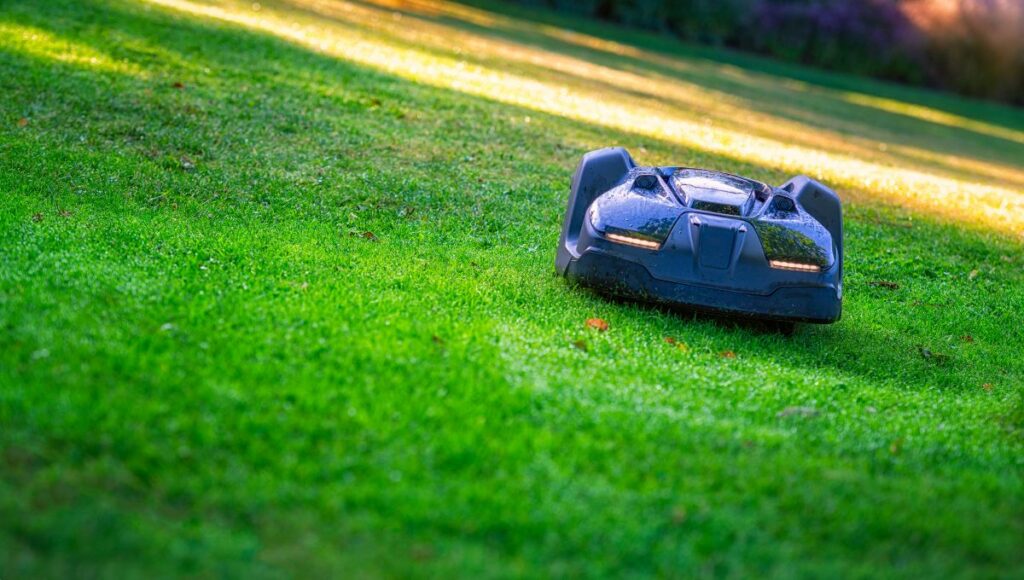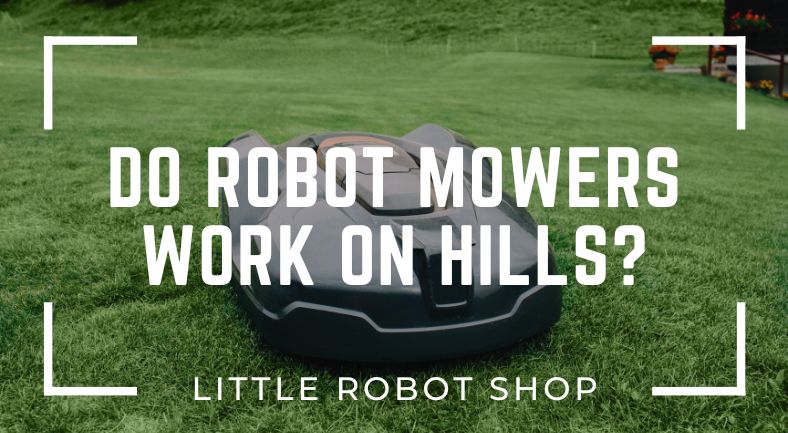Robot lawn mowers are great, but one of the challenges you’ll face when purchasing one is to find the right model that will effectively manage the steep inclines of your lawn. Most robotic mowers can handle small degrees of slopes, but the problem arises when there is an obvious steepness or a large slope degree.
There are robot mowers specially designed for hills and slopes of over 70%, but they often are pricey and may not be what you need. So, how do you find the best robot lawn mower for your steep lawn? We’ll find out in a jiffy.
You may also like:
- How To Work Out Lawn Slope
- How Do Robot Lawn Mowers Navigate? | Guide
- Best Robot Lawn Mower For Hills And Steep Slopes | 9 Amazing Picks With Guide
Can a robotic lawn mower handle sloped lawns?
Most robotic mowers in the market are built to handle some type of slope. Virtually all robot lawn mowers come with a slope rating, this specifies the minimum and maximum amount of slope they can handle. There are 3 different slope rating you’ll usually see on a robot lawnmower, and they include:
- Maximum permissible slope: this specifies the maximum slope gradient value the robot can successfully climb. And it should be contained within the perimeter wire.
- Maximum consistent slope: this specifies the maximum slope gradient value of a lawn the robot can manage.
- Maximum edge slope: this is the maximum slope allowed within 1 meter of your boundary wire.
What slopes can most robotic lawn mowers easily manage?
Robot lawn mower models designed for small lawns and gardens are typically able to handle small slopes, while models designed for larger gardens can handle steeper slopes. Entry-level and mid-range robotic lawn mowers will usually handle slopes of 8.5° to 19° (14% to 34%), while higher-end robot lawn mowers manage slopes of 25° to 28° (46% to 53%), depending on specific design features.
A robotic lawnmower’s slope rating (or maximum incline capability) will differ depending on the specific design features and build quality. Some high-end robotic lawnmowers models like the Husqvarna Automower® 435X AWD which navigates obstacles, rough terrain and steep slopes of up to an impressive 35° or 70 % gradient.

Features That Help Robot Lawn Mowers Work On Hills
There are certain features you’d expect to see in a robotic lawn mower designed to successfully climb steep slopes. For instance, a robotic mower designed to mow steep lawns should have design features that ensure it effectively completes the job. These features include the wheel design, drive motor and slope rating.
Wheel design: a robotic lawnmower built for slopes will have very robust wheels with thick treads that ensure good traction on steep slopes. It’s essential to have good traction when traversing steep terrain, and the wheels are instrumental for maintaining traction.
Drive system: wheel design is one thing, but drive system is another. Most robotic mowers are driven by 2-wheel, but there are also 3-wheel mowers and 4-wheel mowers. It goes without saying that 4-wheel mowers (with an All-wheel drive system) are best suited for slopes because they have the most traction. If you have a very steep lawn, then the best robot lawn mowers for you should at least have a 4-wheel drive system.
Slope rating (Maximum incline capability): This is one factor that determines if a robot lawn mower is truly able to handle slopes. The slope rating or maximum incline capability tells you the exact amount of slope gradient a robot can effectively handle. It’s arguably the most important feature to look for in the best robot mower for slopes and steep inclines.
How to calculate the slope of your lawn
Here is how to calculate the slope of your lawn using stakes, a string and a tape. You may need an assistant to complete the steps.
- Drive a stake into the ground at the highest point of the slope. Drive another stake into the ground at the lowest point of the slope.
- Connect the two stakes with a string, so that it creates a straight, leveled line between the top of the slope and the bottom of the slope.
- Before tying the strings, place some stakes at about 5 feet intervals between the stake at the top of the slope, and the stake at the bottom of the slope. This will help you maintain a straight line. Stretch the string all the way to the next stake and wrap it around it loosely, continue until you get to the last stake at the bottom of the slope.
- Remember that the string line has to be straight and leveled, use a level to ensure that the string is level.
- Measure the length of the string, this gives you the run of the slope
- At the lowest point of the slope, measure the distance from the ground to the string. This gives you the rise.
- Divide the rise by the run, and multiply by 100 to get % of the slope.
Features to Consider When Choosing the Right Robot Mower
Lawn size
Every robot mower has a specified maximum lawn size it can manage, this is often the first thing you need to check when considering a lean mower. The maximum lawn size a robot lawn mower can cover will determine the capacity of the battery, its ability to handle steep hills and also the price. Robot lawn mowers designed for small lawns typically handle small slopes and are the least expensive.
Installation kit
The installation process is the first step in setting up a robot lawn mower for your lawn. Most robot lawn mowers will include an installation kit which often contains perimeter/guide wire, pegs, and tools for installing the robot. But there are some low-cost robots that do not include an installation kit. Purchasing an installation kit on its own can set up back $80 to $120, so you definitely want a mower with a complete installation kit included in the package.
Cutting height and width
Cutting width and height are unique features of robotic lawnmower. Virtually every robot mower has adjustable settings for cutting height (usually between 20-60 mm), this allows you to set your preferred cutting height for your lawn. But the cutting width is not adjustable. As a robot lawn mower mows your lawn, the width of grass it cuts depends on the width of the cutting blades. Robot lawnmowers with narrow cutting width tend to be quieter but slower, while those with wider cutting width tend to be noisier and less power efficient, but they complete the job faster.
Edge cutting ability
Cutting the edges of the lawn is a tricky business for robot lawn mowers. However, some robot lawnmower models handle edge-cutting better than others. Robot mower brands with advanced edge-cutting ability include Worx and Robomow. That doesn’t mean that lawnmowers from these won’t struggle with edges, because they sometimes do, especially if the lawn is bordered by fences.
Battery type
There are two battery types that are commonly seen in robot lawn mowers; lithium-ion battery and lead acid battery. Lithium-ion batteries are obviously better, they last longer, charge faster, are lightweight and have higher energy density. Robot lawn mowers with lead-acid batteries may be cheaper, but those with lithium-ion batteries are better.
Anti-theft features
Since robot lawnmowers stay outdoors, it’s important that they have anti-theft features. The most common anti-features that you’ll find in most robot mowers are pin codes and alarm systems. Most robot mowers come with security pin codes that give only the owner access to program and control the robot. In addition to security pin codes, some robot mowers have an alarm system that goes off if the robot is carried out of its mowing area/perimeter wire. These features discourage theft.

Other Important Things To Know Before Purchasing a Robot Lawn Mower
Weather protection
Obviously, robotic lawn mowers work outside and should be suitable for all types of weather conditions. But, that’s not always the case. Manufacturers usually recommend that you take your robot lawn mower indoors during extreme weather conditions like heavy rains or snow. But, some robot lawnmowers have integrated rain sensors, and they are able to independently react to bad weather. The robot retreats to its charging station when the sensors detect rainy weather to avoid mowing wet grass.
Smartphone compatibility
Smartphones make everything better. Almost every home gadget you can think of has WiFi connectivity with smartphones for extra convenience, so those are some high-end robot lawn mowers. These robots can be monitored and controlled via your smartphone, whether you’re right next door or a thousand miles away, you can get real-time updates on your smart robotic lawnmower.
Collision sensors
For seamless grass cutting sessions, a robot mower should be able to effectively navigate the lawn. Collision sensors in these robots help them to efficiently avoid obstacles on the lawn. A robot lawn mower with collision sensors will smartly detect and avoid solid obstacles (like large tree branches or children’s toys) that could damage the machine or be damaged by the robot.
Safety features
Robot lawn mowers have very sharp blades that would cause a lot of damage to whatever it comes in contact with. To prevent destructive accidents, these robots have a couple of safety features in place. For instance, there are the collision sensors and there are the tilt sensors that automatically stop the spinning blade if the robot is lifted or tilted to a certain degree.
Warranty
Robot mowers are ot exactly cheap, even the cheapest models will still set you back some hundreds of dollars, so getting a decent warranty is a fair deal. A good product from a reliable brand should have at least 12-months warranty and excellent customer service, especially after purchase.

FAQs
Do robot mowers work on uneven ground?
Yes, robot mowers can and do work on uneven grounds, but this can be a challenge for some models. First, you can get your robot to mow uneven grounds better by increasing the cutting height and reducing the cutting speed of the robot, this will prevent scalping. Scalping happens when the blades come too close to the ground and cut grasses from the root.
Can robot mowers go over paths?
It’s possible for a robot mower to safely drive over a flat path, however the perimeter wire should be carefully placed such that it guides the robot to safely cross the path. If your lawn is separated by a pavement walkway, it’s important to find the shorter possible route for crossing the path. Never allow a robot mower to close a gravel or mulch path, as they could damage their blade in the process.
Do robot mowers collect the grass?
No, they don’t. Robot lawn mowers shred and mulch grass into small clippings which are scattered around the lawn to act as manure for your garden.
How long do robot mowers last?
With proper maintenance and prompt replacement of damaged parts, a robot mower can last for as long as 10 to 20 years.
Conclusion
The best robot lawn mowers for slopes and hills are those with the specific design features to effectively handle the task. When choosing a robot mower for a steep lawn, look for a product with a sturdy wheel design, powerful 4WD system and a high slope rating (or Maximum Incline Capability). Robot lawn mowers work best on steep hills if they have a high slope rating. Robot lawn mower brands with the highest slope ratings are Husqvarna Automower and Worx Landroid.

Emma Marie is a valued writer at the Little Robot Shop. She studied robotics and deeply understands technology, which shows in her writing. She consistently produces high-quality content, making her a perfect fit for the Little Robot Shop team.
While not writing, Emma works in a popular electronics retail chain. Emma also enjoys running and has two dogs with whom she loves spending time.
